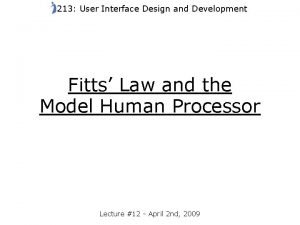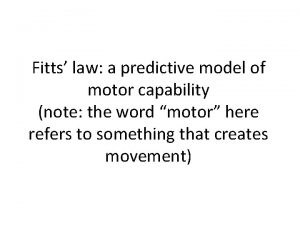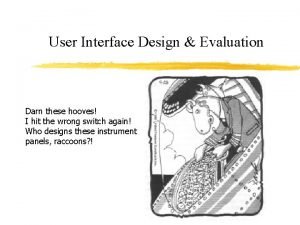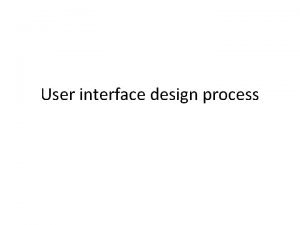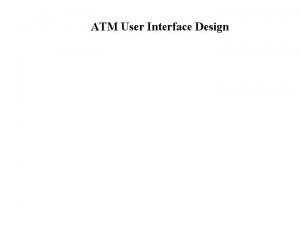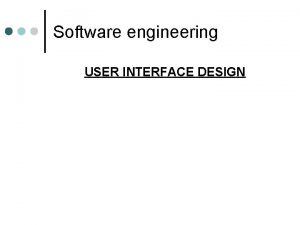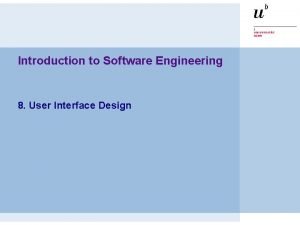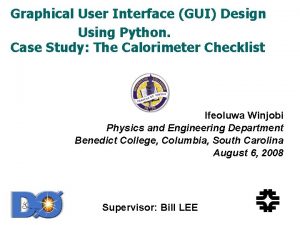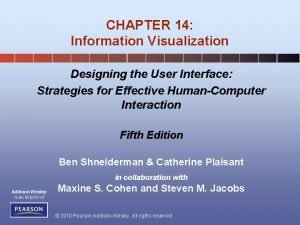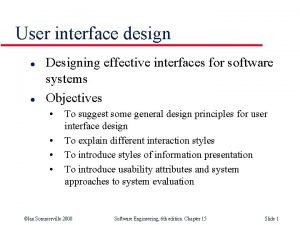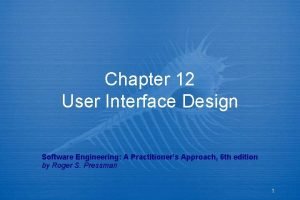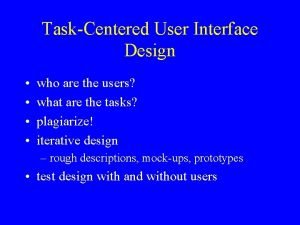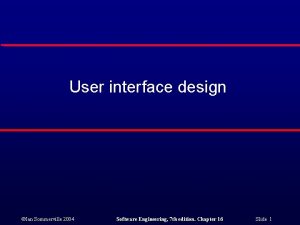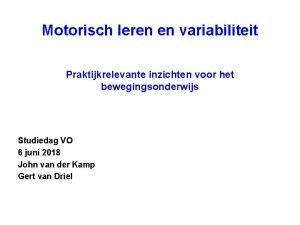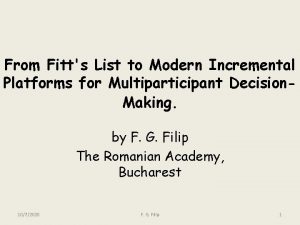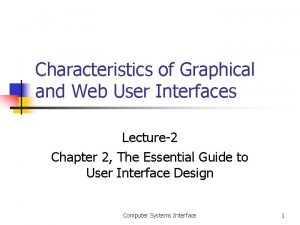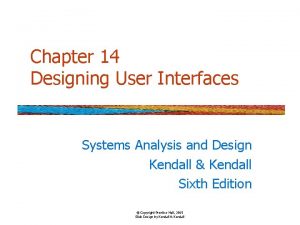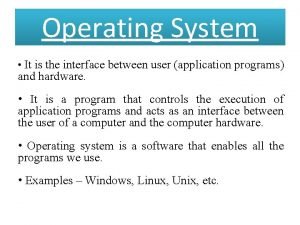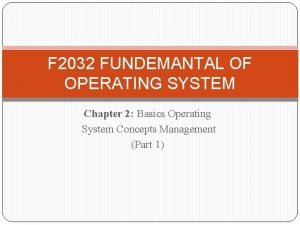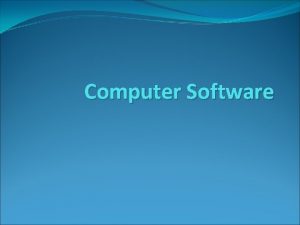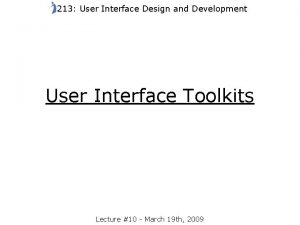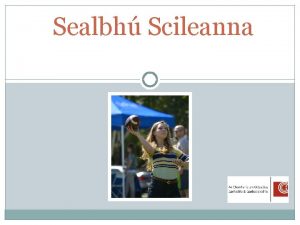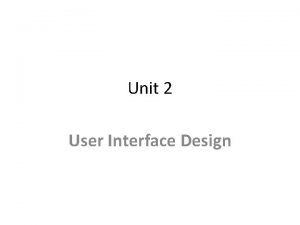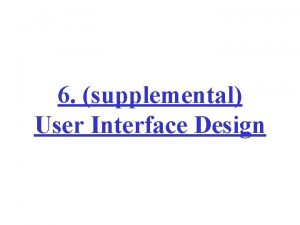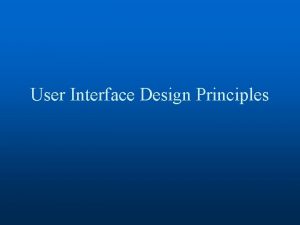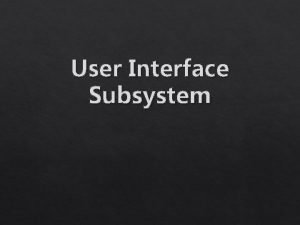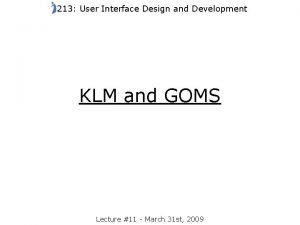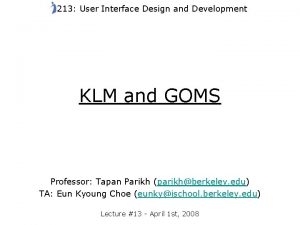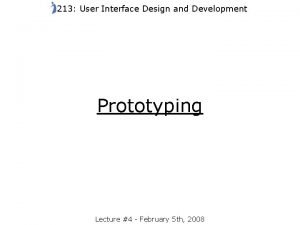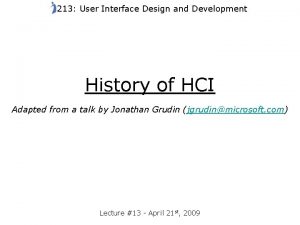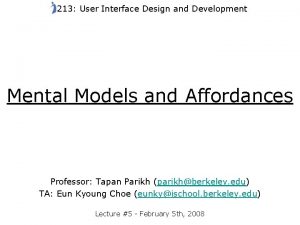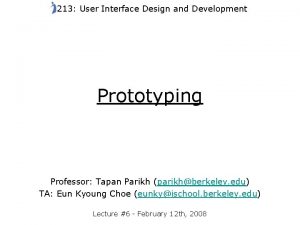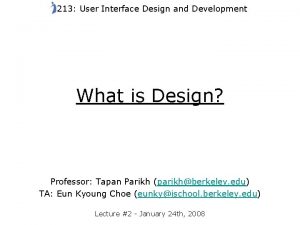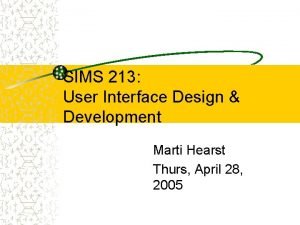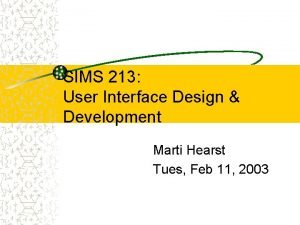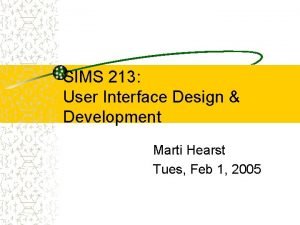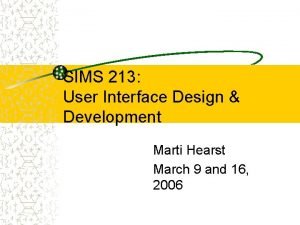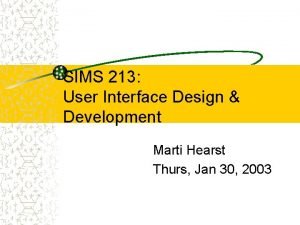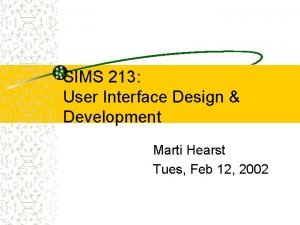213 User Interface Design and Development Fitts Law























![Cycle Time Tc ~ 70 ms [30 -100 ms] – Based on recognize-act cycle Cycle Time Tc ~ 70 ms [30 -100 ms] – Based on recognize-act cycle](https://slidetodoc.com/presentation_image_h/12462eae8d8d70a348d613b4e447899c/image-24.jpg)














- Slides: 38

213: User Interface Design and Development Fitts’ Law and the Model Human Processor Lecture #12 - April 2 nd, 2009

Today’s Outline 1) Fitts’ Law 2) Steering Law 3) Model Human Processor

Fitts’ Law Models movement time for selection Movement time for a rehearsed task – Increases with distance to target (d) – Decreases with width of target (s) – Depends only on relative precision (d/s), assuming target is within arms reach First demonstrated for tapping with finger (Fitts 1954), later extrapolated to mouse and other input devices Adapted from Hearst, Newstetter, Martin

Fitts’ Law Equation Tmsec= a + b log 2 (d/s + 1) a, b = empirically-derived constants d = distance, s = width of target ID (Index of Difficulty) = log 2 (d/s + 1) d s Adapted from Robert Miller

Fitts’ Law Intuition Time depends on relative precision (d/s) Time is not limited by motor activity of moving your arm / hand, but rather by the cognitive activity of keeping on track In below example, time will be the same because the ratio d/s is the same Target 1 Target 2

Fitts’ Law Examples Target 1 Target 2 Adapted from Hearst, Irani

Determining a, b Constants Conduct experiments varying d, s but keeping everything else the same Measure execution time, error rate, accuracy Exclude erroneous data Perform linear regression Adapted from Hearst, Irani

Fitts in Practice Microsoft Toolbars allow you to either keep or remove the labels under Toolbar buttons According to Fitts’ Law, which is more efficient? Source: http: //www. asktog. com/columns/022 Designed. To. Give. Fitts. html Adapted from Hearst, Irani

Fitts in Practice You have a toolbar with 16 icons, each with dimensions of 16 x 16 Without moving the array from the left edge of the screen, or changing the size of the icons, how can you make this more efficient? Adapted from Hearst, Irani

Fitts in Practice Answer: Line up all 16 icons on the left hand edge of the screen Make sure that each button can be activated up the last pixel on the left hand edge Why? Because you cannot move your mouse off of the screen, the effective width s is infinite Adapted from Hearst, Irani

Fitts in Practice Adapted from Landay, Sinha, Klemmer

Steering Law Applies same principles to steering through a tunnel (Accot, Zhai 1997) Must keep the pointer within the boundaries throughout, not only at the target In KLM, Fitts’ Law used for pointing, Steering Law used for drawing D S

Steering Law Equation Tmsec= a + b (d/s) a, b = empirically-derived constants d = distance, s = width of tunnel ID (Index of Difficulty) = (d/s) Index of Difficulty now linear, not logarithmic (i. e. steering is more difficult then pointing) D S Adapted from Robert Miller

Source: http: //linuxbook. orbdesigns. com/ch 09/btlb_c 09. html

Model Human Processor

Model Human Processor Model of human cognition useful for developing user interfaces Summary of decades of psychology research Not an exact model of how the brain operates, but provides a useful approximation for understanding and estimating certain kinds of actions and reactions

Cognitive Models are… Abstract Quantitative Approximate Estimated from experiments Based on a theory of cognition Adapted from Rob Miller


Source: Card, Moran, Newell, The Psychology of Human-Computer Interaction

Model Human Processors – Perceptual – Cognitive – Motor Memories – Sensory Image Store – Working Memory – Long-term Memory Principles of Operation

Model Human Processor “The perceptual system consists of sensors and associated buffer memories… The cognitive system receives symbolically coded information [from the perceptual system] in its working memory, and uses previously stored information from long-term memory to make decisions about how to respond. The motor system carries out the response” Source: Card, Moran, Newell, The Psychology of Human-Computer Interaction

Processors Perceptual – Processes sensory input – Populates sensory image store Motor – Execute physical actions – Operates on working memory Cognitive – Connects perceptions to actions – Operates on working and long-term memory Perceptual Processor Cognitive Processor Motor Processor

Cycle Time Each processor has a cycle time Tp ~ 100 ms [50 -200 ms] – Based on unit impulse response – There is a quantum of experience – Shorter for more intense stimuli Tm ~ 70 ms [25 -170 ms] – Movement is also not continuous, but consists of a sequence of discrete movements (sometimes preprogrammed - talking, typing, etc. )
![Cycle Time Tc 70 ms 30 100 ms Based on recognizeact cycle Cycle Time Tc ~ 70 ms [30 -100 ms] – Based on recognize-act cycle](https://slidetodoc.com/presentation_image_h/12462eae8d8d70a348d613b4e447899c/image-24.jpg)
Cycle Time Tc ~ 70 ms [30 -100 ms] – Based on recognize-act cycle – Parallel recognition, serial action – Can be shorter with task / information loads, and practice For each of the cycle times, there can be up to 10 x difference between the fastest and slowest human beings cycle times calculated both as nominal amounts and ranges

Power Law of Practice The time to do a task decreases with practice Tn = T 1 n-a Tn = time to do task on nth iteration T 1 = time to do task on first iteration A = constant (0. 2 - 0. 6) Applies only to skilled behavior, not to knowledge stored in long-term memory Adapted from Robert Miller

Memories Properties of memories: – Encoding: how things stored – Size: number of things stored – Decay time: how long memory lasts (measured as half-life) Senses Short-term Sensory Store Working Memory Long-term Memory Adapted from Robert Miller

Sensory Image Store Visual information store – encoded as physical image – size ~ 17 [7 -17] letters – decay ~ 200 ms [70 -1000 ms] Auditory information store – encoded as physical sound – size ~ 5 [4. 4 -6. 2] letters – decay ~ 1500 ms [900 -3500 ms] Perceptual memory fades before all of it can be coded and transferred to working memory Adapted from Robert Miller

Perceptual Fusion Two stimuli within the same PP cycle (Tp ~ 100 ms) appear fused – Intuition: will be in the same SIS frame Consequences – 1/ Tp frames/sec is enough to perceive a moving picture (10 fps OK, 20 fps smooth) – Computer response < Tp feels instantaneous – Causality is strongly influenced by fusion Adapted from Robert Miller

Working Memory Holds intermediate products of thinking and coded representations produced by perceptual system – primarily encoded as acoustic or visual codes – organized as “chunks” of information – decay ~ 7 s [5 -226 s] – decay rate is dependent on the number of chunks being recalled – Maintenance rehearsal can keep chunks in working memory – Interference between similarly coded (primarily acoustic) chunks can reduce chance of retrieval – size ~ 7 [5 -9] chunks Adapted from Robert Miller

MWRCAAOLIBMFBIB

MWR CAA OLI BMF BIB

BMW RCA AOL IBM FBI

Chunking “Chunk”: unit of perception or memory Chunking depends on presentation and what you already know MWRCAAOLIBMFBIB MWR CAA OLI BMF BIB BMW RCA AOL IBM FBI 3 -4 digit chunking is ideal for encoding unrelated digits Adapted from Robert Miller

Long-term Memory Holds the mass of the user’s knowledge and experiences Network of inter-linked chunks, accessed associatively from working memory – – primarily encoded as semantic links decay ~ infinite size ~ infinite fast-read, slow-write Working on complicated tasks means less time for transferring from working memory to long-term memory Adapted from Robert Miller

Retrieval from LTM Retrieval of LTM chunks is based on what other chunks it is associated with (retrieval cues) Elaborative rehearsal can create more links, increasing chances of retrieval Interference between similarly coded (semantically similar) can reduce chances of retrieval Recognize-act cycle: On each cycle of the cognitive processor, the working memory contents initiate actions associated with them in long-term memory; these actions in turn modify the contents of working memory by creating new sensory perceptions

Adapted from Landay, Sinha, Klemmer

Uncertainty Principle Response time RT increases with uncertainty about the judgment or decision to be made; proportionally to the information content of the stimuli For example, for n equally probably stimuli, each requiring a different response RT = c + d log 2 (n + 1) Where c, d are constants Adapted from Robert Miller

For Next Week Tuesday is an open day to work on your project On Thursday Deepti will discuss Qualitative Methods in UI design and evaluation using a case study project Interactive Prototype #2 and Experiment Design due on April 15 th!
 Fitts law user interface design
Fitts law user interface design User interface design in system analysis and design
User interface design in system analysis and design User interface design in system analysis and design
User interface design in system analysis and design Fitts law calculator
Fitts law calculator Fitts law ux
Fitts law ux User interface analysis and design
User interface analysis and design User interface design and implementation
User interface design and implementation User interface design and evaluation
User interface design and evaluation Input design principles
Input design principles User interface design cycle
User interface design cycle User interface in software engineering
User interface in software engineering Graphical user interface design principles
Graphical user interface design principles Atm user interface design
Atm user interface design Types of user interface in software engineering
Types of user interface in software engineering User interface design principles in software engineering
User interface design principles in software engineering Python user interface design
Python user interface design Visualization in user interface design
Visualization in user interface design Recoverability in user interface design
Recoverability in user interface design User interface design steps in software engineering
User interface design steps in software engineering Task centered user interface design
Task centered user interface design User interface design process in software engineering
User interface design process in software engineering Labview user interface design examples
Labview user interface design examples User interface design process in software engineering
User interface design process in software engineering Fitts en posner
Fitts en posner Exposed naked
Exposed naked Fitts list
Fitts list Newton's first law and second law and third law
Newton's first law and second law and third law Newton's first law and second law and third law
Newton's first law and second law and third law Characteristics of graphical user interface ppt
Characteristics of graphical user interface ppt User interface and its types
User interface and its types Interface between user and kernel
Interface between user and kernel Operating system and user interface
Operating system and user interface Application software interface
Application software interface Single user and multiple user operating system
Single user and multiple user operating system Single user and multi user operating system
Single user and multi user operating system Interface in interface java
Interface in interface java Office interface vs industrial interface
Office interface vs industrial interface Industrial interfaces
Industrial interfaces Interface------------ an interface *
Interface------------ an interface *
